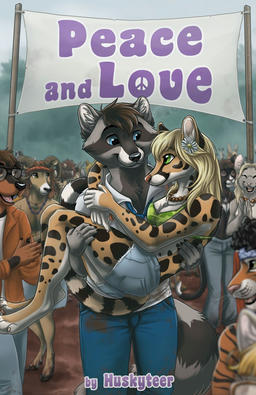A review of Huskyteer’s charming 1960s furry period romance.
Review: Peace and Love
Arilin Thorferra
So, last week on Mastodon and Bluesky, I posted,
As part of Project Do Nice Things to Keep From Going Insane in 2025*, I am committing to reviewing furry books I’ve liked. I’ll be aiming for one per month, give or take. First up: cheating by picking two things I’ve already read, “Peace and Love” and “Induction”.
*Still workshopping this title
And as a cat of my word trying to keep from going insane, it’s time for that first review!

Peace and Love
Alice “Huskyteer” Dryden
FurPlanet Productions
December 2023
Print Edition $14.95
Ebook Edition $4.95 (DRM-free)
Huskyteer wrote one of my favorite furry science fiction stories, “The Analogue Cat,” which won both a Coyotl and an Ursa Major award (furry’s two writing awards—yes, we have them, sort of the rough equivalent of the Nebula and Hugo awards, respectively), manages to pull off being written in second person present tense, and will make you cry happy ugly tears unless you are an absolute monster. Peace and Love is a markedly different kind of story, no less romantic and emotional—and an awful lot of fun.
Peace and Love is a novella-length expansion of one of the earliest stories by Huskyteer I read, a romance set in a furry version of New York City in the 1960s. The protagonist, Roger Jones, is a college student raccoon living in a house in Greenwich Village. Roger’s a straight-laced law student who lucked into owning the house after it was left to him in a relative’s will; his vulpine roommate Frank is just about Roger’s diametric opposite: a freewheeling hippie who eats weird food, smokes weird things, and especially has weird friends. Despite Frank’s promise not to “interfere with Roger’s scene,” the raccoon finds himself having to sneak around the house not to get into conversations with the hippies. The story opens with this strategy failing.
Creeping up his own stars to his own bedroom in his own house so as not to disturb his uninvited guests, Roger considered his scene thoroughly interfered with.
The blind in his room was drawn to keep his books from fading in the sunlight, so it took Roger a moment to notice the naked girl in the middle of the floor.
He assumes her introduction of “Peace Man” is a flower child greeting, but it’s actually her name: she’s a linsang, a species he’s never seen before. Roger is both flustered and enchanted. After his chance meeting with the linsang, Roger inquires about her with Frank:
“You and her—you’re not…” Roger’s heart clutched painfully.
“No, you’re cool. Peace is like a sister to me. As a matter of fact I don’t dig chicks, if you get me.”
Roger took a step back. “Oh—I’m sorry.”
“Don’t be. It’s a beautiful scene.”
Roger is shocked to learn he’s been living with (gasp) a homosexual, but decides that he can handle it, for now. Frank’s sexuality isn’t an incidental detail: while Peace and Love is very much the sweet period romance it presents as, Huskyteer deftly weaves the politics of the time into the plot—politics that very much echo issues we’re still dealing with today, from homophobia to police misconduct. There are sit-ins, police raids, questions about the war, and shifting relationships among a surprisingly large cast. Through the ups and downs of his involvement with Peace, Roger learns a lot about his own hangups and biases—but everyone, not just Roger, has baggage to work through.
All the characters are lovely; they frequently start out as identifiable stereotypes (uptight square, scatterbrained hippie, Earth mother, and so on), but they quickly reveal depth and complexity. The stakes of the story aren’t about saving the world, but about saving friendships and relationships—and about what choices you’ll make, what costs you’ll pay, when your principles are at stake. As light as the story may be on its surface, it reveals its own depth and complexity if you look, with a lot to say about prejudice and privilege.
The 1960s setting is exquisitely well-drawn—Huskyteer’s own love for the period shines through brightly. Peace and Love is a quick read, just a little over one hundred pages in the print version. It’s absolutely worth your time.